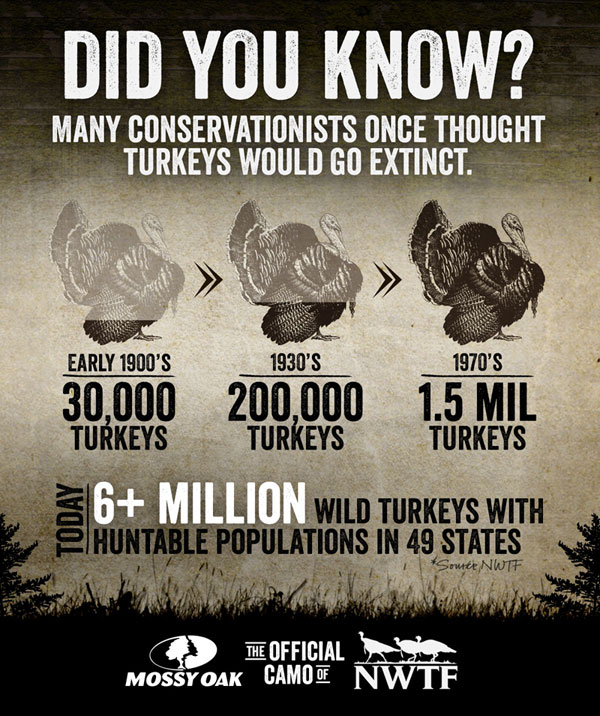There once were six geographic subspecies of wild turkey in North America, one of which is extinct. That subspecies of turkey is the Mexican wild turkey, and today’s domestic turkeys are believed to be descended from it. The five subspecies of wild turkey alive today are the eastern, Osceola (or Florida wild turkey), Merriam’s, Rio Grande and Gould’s.
In the 1500s, the wild turkey population in the United States was approximately 10 million. As unregulated hunting pressure and habitat loss increased, the turkey population rapidly declined. Wild turkeys had once occupied 39 states and by 1920, they were down to 21 states. The lowest population estimate is 30,000.
The first attempts at restoring the wild turkey population were not very effective. Capturing the wild turkey proved difficult, so attempts were made to raise turkeys in pens on game farms. Two state agencies (Virginia and Pennsylvania) released approximately 2000 of the farm-raised turkeys, but there was little to no evidence that these populations were viable. What was learned through this process was that survival behaviors are learned from wild hens. The juvenile turkey lacked the capacity to survive on its own in the wild.

Success came in the 1950s and 60s as methods for capturing wild birds were improved and refined. Capturing wild turkeys for relocation efforts was primarily funded by hunters through licenses and excise taxes.
An undertaking by hunter and wildlife biologist Herman (Duff) Holbrook in South Carolina resulted in a 50-percent success rate. Four of eight wild turkey group releases were able to reproduce successfully. By 1959, 31 states were pursuing efforts to restore the wild turkey population. The desire to recover populations as a source of hunting recreation and food procurement were foundational in wild turkey restoration as was the engagement of hunters themselves in many capacities.
Between 1951 and 1974 the wild turkey population in the U.S. grew from an estimated 320,000 animals to 1.4 million. This growth reflected the adaptability of the wild turkey to changing habitat. Hunting seasons grew from 20in 1958 to 39 in 1974.
Then National Wild Turkey Federation (NWTF) was founded in 1973 by Tom Rogers. Its mission: conserve wild turkeys and preserve hunting heritage. Programs, funding and actions on public policy through the NWTF helped increase turkey populations and turkey hunters. By 1994, there were 2.1 million turkey hunters harvesting 654,000 birds annually. By the end of the twentieth century, the birds’ range had increased as well and the wild turkey population at that time was estimated at 5.4 million birds.
Wild turkeys are currently found in 49 of 50 states, six Canadian provinces and in central and eastern Mexico. The species current range is larger than at any time in recorded history.
Source: Wild Turkey Population History and Overview courtesy of the NWTF.






























